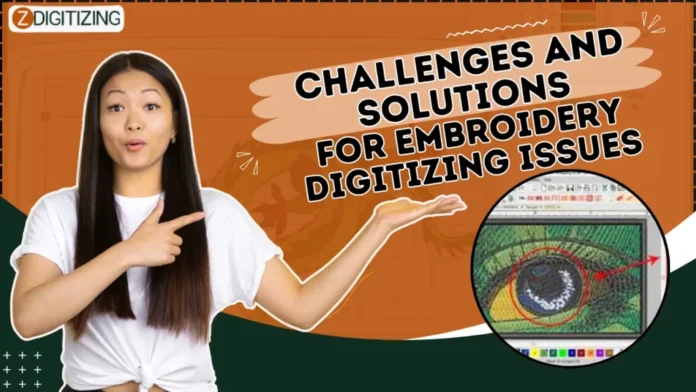Embroidery digitizing is a complex process that involves converting artwork or designs into stitch patterns for embroidery machines to replicate. While digitizing services and embroidery file format converters have simplified this process, embroiderers still encounter various challenges along the way. In this guide, we’ll explore common embroidery digitizing issues and provide practical solutions to overcome them.
1. Complex Designs
Challenge: Embroidering complex designs with intricate details can pose challenges in digitizing, particularly when translating fine lines and small elements into stitch patterns.
Solution: Simplify complex designs by reducing unnecessary details and emphasizing key elements. Utilize digitizing services to optimize designs for embroidery, adjusting stitch settings and densities to ensure clarity and precision.
2. Small Text
Challenge: Digitizing small text for embroidery presents challenges in achieving legibility and clarity, especially when working with intricate fonts or delicate fabrics.
Solution: Increase letter spacing and adjust stitch density to improve legibility of small text. Utilize embroidery file format converters to optimize font shapes and sizes for clear stitching on fabric. Test small text designs on scrap fabric to evaluate readability before embroidering on final projects.
3. Color Changes
Challenge: Managing color changes in multi-color designs can be time-consuming and labor-intensive, leading to inefficiencies and potential errors during embroidery.
Solution: Streamline color changes by grouping similar colors together and minimizing unnecessary thread changes. Utilize digitizing services to consolidate color changes and optimize stitch sequences for efficient production. Invest in embroidery machines with automatic color-change capabilities to reduce manual intervention.
4. Stitch Distortion
Challenge: Stitch distortion can occur during embroidery, resulting in misshapen or distorted designs, particularly when working with stretchy or delicate fabrics.
Solution: Use high-quality stabilizers and proper hooping techniques to minimize fabric distortion during embroidery. Adjust tension settings and needle types to achieve optimal stitch quality and prevent puckering. Utilize digitizing services to optimize designs for specific fabric types and embroidery techniques, ensuring consistent results.
5. Thread Breaks
Challenge: Thread breaks can disrupt the embroidery process and lead to incomplete or flawed designs, causing frustration and downtime for embroiderers.
Solution: Address thread breaks by ensuring proper thread tension and thread path alignment. Regularly maintain embroidery machines, including cleaning and oiling components to prevent friction and thread snags. Utilize high-quality threads and needles suitable for the chosen fabric to minimize breakage.
6. Inconsistent Stitching
Challenge: Inconsistent stitching results in uneven or irregular patterns, detracting from the overall quality and appearance of embroidered designs.
Solution: Calibrate embroidery machines regularly to ensure consistent stitching across designs. Conduct test stitches on scrap fabric to assess stitch quality and make necessary adjustments to tension, speed, and needle placement. Utilize digitizing services to optimize stitch settings and minimize variances in stitching quality.
7. File Compatibility Issues
Challenge: Compatibility issues with embroidery file formats can arise when transferring designs between different software programs or embroidery machines, leading to errors or incomplete conversions.
Solution: Use embroidery file format converter to translate designs into compatible formats for specific machines and software. Standardize file formats within your workflow to minimize compatibility issues and streamline production processes. Communicate with suppliers and partners to ensure seamless file transfer and compatibility across systems.
8. Complex Outlines
Challenge: Embroidering designs with complex outlines or intricate details can pose challenges in maintaining clarity and definition during stitching.
Solution: Simplify complex outlines by reducing unnecessary details and emphasizing key features. Utilize digitizing services to optimize designs for embroidery, adjusting stitch densities and outlining techniques to enhance clarity and precision. Conduct test stitches to evaluate the effectiveness of outline designs before embroidering on final projects.
By addressing these common challenges and implementing practical solutions, embroiderers can overcome obstacles in the digitizing process and achieve high-quality results. Utilize embroidery file format converters and digitizing services to streamline workflows and optimize designs for efficient and precise embroidery production.





